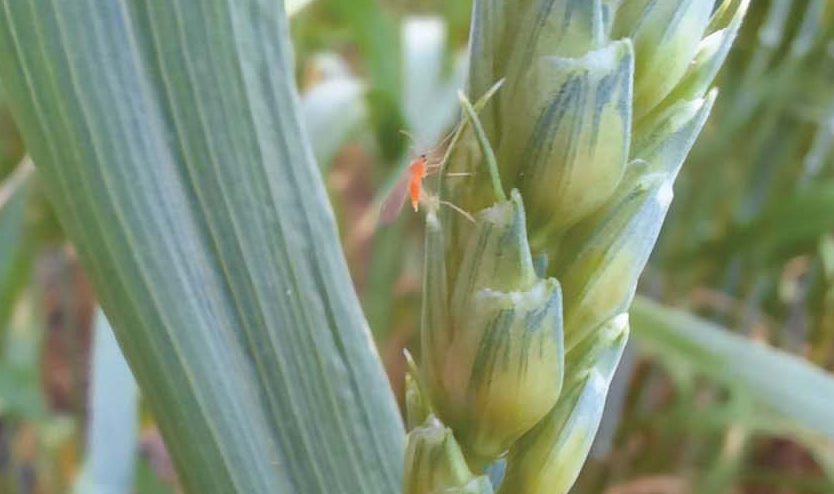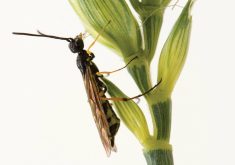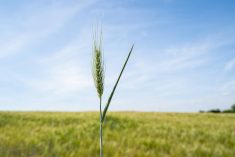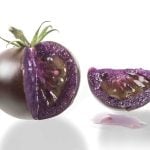Wheat midge populations on the Prairies have been declining for the past few years, but a researcher specializing in insect pests says farmers need to remain vigilant about the threat they pose to crops.
“My advice (to farmers) is don’t turn your back on wheat midge, even if you are in a (low level) green zone on the provincial survey map,” says Tyler Wist, a field crop entomologist with Agriculture and Agri-Food Canada in Saskatoon.
“This is the biggest pest in wheat that we have in Western Canada and it’s not something that you want to take lightly.”
Read Also

Claas brings 1000 Series SP forage harvesters to Canada
In mid-August, Claas unveiled its new line of Jaguar forage harvesters at an event in Visalia, California, deep in the heart of that state’s dairy region.
Wheat midge populations in Western Canada have been falling since the summer of 2021 when severe drought led to a significant decline in crop yields and a corresponding drop in the insect pest’s numbers.
That trend continued this past year. An insect pest survey conducted by the province of Saskatchewan showed significantly reduced populations of wheat midge in 2023 compared to 2022, although noteworthy hotspots were found north of Regina and some smaller dense populations were identified near Saskatoon, Kindersley and Lloydminster.
Alberta’s 2023 wheat midge survey results indicated a low population of wheat midge throughout the province, with the exception of a few fields in the Camrose and Edmonton regions.
Despite the declining numbers, Wist says producers should not be lulled into a false sense of security about the potential peril that wheat midge pose. Research has shown they can remain dormant in the soil for up to 13 years and can quickly become a concern again when an area receives normal or average rainfall levels.
“Thing can turn around pretty quickly,” says Wist. “They’ll come roaring back in a hurry if conditions are right.”
Full speed ahead
Now, he adds, is not the time for producers to take their foot off the gas when it comes to choosing midge-tolerant seed varieties.
“The best thing you can do is plant that midge-tolerant wheat because it’s there and it’s taking care of the wheat midge for you,” he says.
“You may be paying a bit more for it, but these days the midge-tolerant wheat is outyielding all of the midge non-tolerant wheat. The thing is, you never know when these insects are going to show up. We’re talking possibly 90 per cent yield loss in a field and that can happen in just a couple of days of females flying around in your field.”
Midge-tolerant wheat varieties were first developed by Agriculture and Agri-Food Canada following several major outbreaks of wheat midge on the Prairies in the 1990s. It’s estimated 32 per cent of all wheat now planted in Western Canada is midge-tolerant.
Such varieties have been available for the past 13 seasons. They contain a gene known as Sm1, which works by ramping up the production of phenolic acids in the seed when a midge starts to feed on it. The wheat midge doesn’t like the taste of those acids, stops feeding and subsequently starves to death.
Eileen Beaton, a crops extension specialist with the Saskatchewan government, says in a blog post several midge-tolerant wheat varieties are available for 2024, including varietal blends in CWRS, CPSR, CWSP, CWSWS, CWHWS, CHNR, CWES and durum wheat classes. A total of 36 varieties are registered and available for planting this season. More information on them is available online.
Another option to manage wheat midge risk is rotation to a non-host crop. Since spring wheat is the primary host for wheat midge, Beaton suggests producers consider planting a non-susceptible cereal crop such as oats or barley or a broadleaf crop such as canola or pulses, since midge adults are not strong fliers.
Difficult to detect
The wheat midge’s full name is the orange wheat blossom midge (Sitodiplosis mosellana). As its name suggests, it’s orange in appearance. It’s a member of the fly order (Diptera), although it closely resembles a mosquito because of its small size.
The adult wheat midge is not a threat to crops; rather, its larvae are. The adult female lays her eggs underneath a plant’s glumes, or leaf-like structures. Once those eggs hatch, the larvae tap into the wheat head’s developing kernel, causing the kernel to completely shrivel up and produce an unharvestable seed.
Part of what makes the wheat midge a formidable foe for farmers is that it can be difficult to detect until the damage has already been done.
“When it happens, you’re like, where did my seed go?” says Wist. “There’s no obvious exterior damage to the plant. You don’t see bites. You don’t see feeding damage.”
That’s why it’s important producers scout their wheat fields for the midge when it first emerges and is in its susceptible period, he says.

Wheat midge normally begin to emerge just before the Canada Day long weekend or soon after and emergence usually follows a significant rainfall. Growers, when scouting, should look for females crawling on heads in the plant’s canopy. The females generally lay their eggs at dusk or dawn when humidity is in the 60-70 per cent range and winds are calm. The economic threshold for yield is one female wheat midge for every five heads of wheat, which translates into a yield loss of about 15 per cent.
Three years ago, Wist teamed-up with SeCan, an independent seed retailer, as part of an initiative known as Midge Busters (#midgebusters on X). The project distributes pheromone traps to agronomists and farmers across Western Canada free of charge. Those traps are used to track the presence of wheat midge in farm fields and the data collected is then used to compare provincial midge forecasts with actual spring and summer emergence.
So, what causes some areas to become hotspots for wheat midge while other locations remain relatively untouched? Warm weather and precipitation are key factors, Wist says — but the truth is, much remains unknown about the pest and its habits.
“The pheromone trapping is something that I’m trying to continuously expand because more data is always better,” he says. “We can fill in those gaps in those areas to help determine what’s truly going on in some regions … like why is one region booming and another one isn’t?”
Diminished insecticide options
For farmers who choose non-midge tolerant wheat varieties, the number of insecticide options has recently diminished. Insecticides containing the active ingredient chlorpyrifos, such as Lorsban 4E, can no longer be used as they have been deregistered by Health Canada.
Beaton says some alternative insecticides such as Cygon and Lagon, which contain the active ingredient dimethoate, are available for use.
Wist says producers who use those products need to be extremely careful to apply them at the right time. If they are sprayed too late they will have little impact on the adult wheat midge or the eggs the females lay.

Those products can also cause harm to parasitic wasps known as Macroglenes penetrans, which are a natural enemy of wheat midge and help to keep their numbers low.
“It’s a really good predator of the wheat midge,” Wist says. “It acts by killing those over-wintering cocoons of the wheat midge. Not spraying for wheat midge too late helps to preserve populations of those parasitoids.”
















